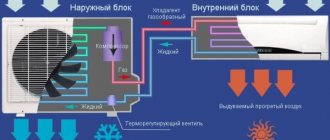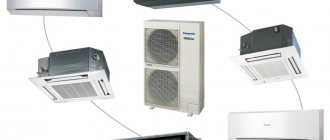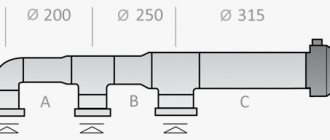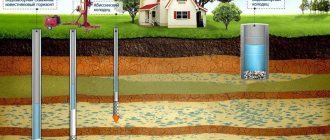When is freon refilling required?
According to statistics, even the highest quality air conditioner loses up to 8% of the pumped refrigerant during the season. This means that at least once every 2 years the home climate system needs to be refilled with freon.
A clear sign of the need for such maintenance is an increase in the time it takes to set the specified climatic parameters. However, it is quite difficult to clearly judge that it is time to refill the air conditioner.
Loss of cooling capacity can be caused by more than just a refrigerant leak. It is no less affected by contamination of the evaporator and condenser, radiators, and problems with the operation of the fans of the external unit of the split system.
With a high degree of certainty, we can judge the need for refrigerant charging only if the system undergoes maintenance at the correct intervals, and after cleaning the components, the cold performance has not reached the optimal level.
Periodic refueling is required during operation
The frequency of equipment cleaning largely depends on the location of the unit:
- Split systems on floors 1-4 need to be cleaned before the start of each season.
- When installing blocks at a height of 5 - 8, cleaning can be done once every 2 years;
- Blocks on the 9th floor and above need to be cleaned no more than once every 3 years.
Expert opinion
Starostin Konstantin Adreevich
Air conditioner installation and maintenance specialist
If the air conditioner is used in winter, cleaning will be required much more often - at least once a month, and in some cases - once a week.
Most equipment owners have no idea how to charge their home air conditioner themselves. In reality, this process is not so complicated, but it will require certain knowledge about the design of equipment, the availability of specific devices and tools, and skills in their use.
At the same time, some errors (for example, an excessive amount of refrigerant in the system) can lead to completely the opposite result - instead of restoring operating parameters, the air conditioning unit will completely fail. To avoid such an unpleasant outcome, entrust the work of refueling to the service center specialists.
Another compelling argument in favor of such a decision is the very insignificant savings when doing the work yourself (in the best case, it will be 2-3 thousand rubles).
The need for work
When purchasing new equipment, it does not need to be filled with freon, since this is done by the manufacturer. During repairs, the refrigerant is pumped into the outdoor module. The main thing is to do this carefully and not allow it to leak. Another thing is cleaning, which is carried out as planned.
Freon refilling of air conditioners is carried out in the following cases:
- if it leaked during installation or transfer to a new location;
- after disconnecting the main lines for subsequent repairs;
- after a freon leak as a result of a seal failure.
Window devices rarely need such a procedure, which cannot be said about car devices. Constant vibration leads to loss of refrigerant.
According to the recommendations of the companies, refilling the air conditioner with freon should be done once a year. Practice shows that such a frequency is not necessary. It is enough to carry out the procedure every 4-5 years. This is due to the high quality of butt joints. If a leak occurs, the device is disassembled and fault locations are searched.
There are signs indicating a freon deficiency in the system:
- due to a decrease in the efficiency of the equipment, the indoor unit begins to blow warm air;
- the compressor begins non-stop operation at maximum load;
- the display shows an error;
- the service port of the external unit with the liquid entering it becomes covered with ice;
- The evaporator of the indoor unit freezes.
We recommend that you read: Air conditioning for server rooms
Refueling or refueling
The logical option for restoring the operation of the air conditioner in the event of a refrigerant leak from the circuit is to restore its quantity in the system or refill it.
However, in the case of climate control technology, this logic does not always work:
Refilling is possible only if the split system operates with one-component freon (contains only 1 substance). These include, for example, R22 and R32.- For multi-component freons, refilling is unacceptable. This is due to the fact that different components in the refrigerant have different properties, therefore, in case of leaks, they are also consumed differently. Refueling causes an additional imbalance in the ratio of the components of the mixture, which can significantly affect the characteristics and even the performance of the equipment. Most freons used today, including the most popular R410A, are multicomponent. For them, instead of refueling, the system must be completely refueled.
Expert opinion
Starostin Konstantin Adreevich
Air conditioner installation and maintenance specialist
Some multicomponent freons are sanitary mixtures - compositions in which the components are similar in properties. This allows them to maintain composition stability, which means refueling is permissible. The type of refrigerant is indicated in the technical documentation for the air conditioner; its properties can be found in reference books.
Preparing for refueling
You need to start preparing to refill the air conditioner by cleaning it. This will allow you to achieve optimal performance of all system components and, accordingly, eliminate measurement errors associated with deviations of operating modes from optimal ones.
The filters of the indoor unit of the split system and its outdoor unit need cleaning.
The latter is serviced in the following sequence:
It is advisable to carry out mechanical cleaning
- De-energize the equipment.
- Carry out mechanical cleaning:
- remove dirt and dust from the outside of the casing;
- dismantle it;
- remove accumulated debris from inside the housing.
- Perform flushing. For this:
- cover the electronic unit with polyethylene to prevent water from entering;
- Use a damp sponge to remove dust and dirt from the fan blades and structural elements;
- clean the capacitor in the same way;
- Use a hand-held vacuum cleaner to remove dust in hard-to-reach places.
- Clean the radiator. To do this, use special brushes, rinse the cells with water under pressure or use a steam cleaner.
- Install the casing and leave until the moisture dries completely.
To avoid damaging the electronic unit, the user should not clean it themselves. This work should only be carried out by specialists with the appropriate level of qualification!
The next stage of preparation is to check the system for leaks. If the refrigerant leak rate exceeds the permissible rate (the same 8% during the season), most likely there are problems with the sealing of the connections. You can find the location of a serious leak by visually inspecting the lines and connections.
If it was not possible to find the problem area by simple inspection, other methods will help using:
Ultraviolet dye
Soap solution . Works well if the suspected location of the leak is known.
- Halogen finder . Uses the effect of changing the color of the flame when interacting with chlorine vapor. Can only be used on equipment with chlorine-containing freons.
- Water . Requires preliminary injection of nitrogen into the circuit and immersion of system parts in water, which is not always convenient.
- Ultraviolet dye . A UV dye is added to the gas pumped into the system, which indicates the location of the leak. Finding it is easy with ultraviolet illumination.
Expert opinion
Starostin Konstantin Adreevich
Air conditioner installation and maintenance specialist
If there is a suspicion of a leak due to leaks in connections or system components, the refrigerant should be removed from the system, filled with nitrogen, searched for problem areas, troubleshooted, and pressure tested and evacuated the system.
Pressure testing of the system involves pumping the circuit with nitrogen through a pressure gauge manifold. Injection is carried out according to the permissible pressure in the circuit (indicated in the technical documentation and on the device nameplate).
Once the pressure is reached, the nitrogen supply to the system is stopped. In a sealed system, the pressure will remain constant; if leaks persist, nitrogen will continue to be released. In this case, the procedure for searching for problem areas and crimping should be repeated.
Vacuuming
After the tightness has been restored (the system has been pressurized), vacuuming is performed:
- A vacuum pump is connected to the pressure manifold.
- Start the pump and open the gas valve.
- I control the pressure in the system using the pressure gauge.
- When the minimum is reached, the pump is turned off.
- Close the gas valve.
During operation, a vacuum pump with a check valve is used, which will prevent oil from entering the freon circulation circuit. After pressure testing and evacuation, the collector is not turned off to prevent air from entering the system.
Signs of a freon leak
With careful attention to the air conditioner and timely maintenance, it is easy to determine that the operation of the equipment has deteriorated and external changes have occurred. Signs of a freon leak:
- The performance of the air conditioner has deteriorated, it has stopped cooling/heating the air as quickly as before, it does it weakly and ineffectively.
- The compressor protection sensor is constantly activated, reacting to excess heat. It stops the operation of the equipment.
- Darkening of the compressor insulation.
Refrigerant leak at pipes
- The presence of oil on the elements of the split system, a burning smell after switching on, oxidation of the oil (checked by testing for acidity level).
- Burnt insulation near the capillary tube, supply pipeline.
- Icing of the pipes of the external unit.
Icing of the external pipe of the air conditioner
As soon as signs of a freon leak appear, you must turn off the air conditioner and do not use it until the problem is resolved. The best thing is to call specialists who will test the system, find the cause of the breakdown, and eliminate it. After all, the cause of the malfunction may not only be a coolant leak.
If you are completely sure that the cause of the malfunction is a leak, it seems possible to eliminate it yourself by refilling the system with refrigerant.
You might be interested in how household air conditioners are repaired >>>
Refilling the air conditioner
Refilling the air conditioner is carried out only after removing all the old refrigerant from the circuit. If the preparation was carried out with crimping and vacuuming, this stage has already been completed. Otherwise, you need to open the locks of the service fittings and wait until the old freon is completely removed from the circuit. Once completed, close the locks.
To refill the air conditioner, you need to know how much refrigerant needs to be pumped into the circuit.
The two best options for such control:
- Refueling by weight.
- Pressure filling.
In the first case, the mass of freon specified in the technical documentation is pumped into the system. For this:
The refrigerant cylinder is connected to the manifold.- Place the cylinder on an electronic or mechanical scale.
- Set to zero.
- Open the gas valve and fill the system with freon.
- Monitor scale readings.
- When a given change in the weight of the cylinder is achieved (pumping a given mass of freon into the circuit), the valve is closed.
- Disconnect the cylinder from the manifold.
- Remove the manifold and close the service fitting on the line.
Expert opinion
Starostin Konstantin Adreevich
Air conditioner installation and maintenance specialist
When charging by weight, when determining the weight of freon, it is necessary to take into account the length of the lines. Manufacturers indicate the required mass of refrigerant taking into account the permissible or minimum circuit length. In the second case, 15-30 g of freon is added for each meter of line (depending on the type).
What does freon do in an air conditioner?
Let's take a brief look at what exactly freon does in an air conditioner:
- The refrigerant leaves the evaporator as low pressure, low temperature vapor.
- The compressor increases the freon pressure to 15-20 atmospheres and the temperature to +70-90º.
- The refrigerant enters the condenser. There it cools and turns into a liquid state, and releases heat. In simple air conditioner models, this heat is removed outside the room. In models with heating - used to heat the room.
- Next, the freon enters the evaporator. Here its pressure decreases, and the freon boils and turns into gas. At this stage, the refrigerant releases cold, which cools the room.
That is, it is the freon circulating inside the air conditioner that cools and heats the air in the room.
What kind of freon is used in household air conditioners
There are about 40 different types of freons.
The following brands of refrigerants are used in domestic (home) air conditioners:
- R-407C. It is impossible to refill an air conditioner with such a refrigerant, since if it leaks, it changes its composition and loses its characteristics. Therefore, such split systems are only completely refilled (the old freon must be drained and then refilled with new one). An 11.3 kg cylinder costs about 6,500 rubles.
- R-410A. Unlike R-407C, it does not lose characteristics when leaked. Therefore, systems with this refrigerant can be topped up. A cylinder weighing 11.3 kg costs about 8,000 rubles.
- R32. In terms of thermal conductivity and performance - 5% more efficient than R-410A. It also does not need a complete replacement - if there is a leak, the system can be topped up without draining all the refrigerant. A cylinder weighing 10 kg costs about 8000-8500 rubles.
- R22. Since 2010, this refrigerant has been banned in the USA and Europe, since 2015 - in the Russian Federation (since it harms the ozone layer of the Earth). If you have an old split system, it can still work on this freon. New ones are already produced on other brands. Systems with R22 refrigerant can be filled with R-407C.
Filling by pressure
In this case, the sequence of actions remains the same, but the freon cylinder is not installed on the scales, and the supply is not carried out in a continuous flow, but in portions. The pressure in the system is monitored with a manifold pressure gauge. The supply is continued until the nominal pressure value is reached.
The pressure in the system depends on the temperature. Optimal values are indicated in the technical documentation or in the table on the unit nameplate. If necessary, for a specific temperature value it is easy to calculate corrections using tabular data.
Based on the pressure, you can also refuel the system. After connecting the manifold, the device displays the current refrigerant pressure. Pumping from the cylinder is carried out until the nominal value is reached.
Refueling due to overheating
Refueling due to overheating
The method is based on reducing the temperature difference in the circuit and the boiling point of the refrigerant. For work:
- Turn on the unit.
- An electronic thermometer is installed on the gas pipe. It shows the temperature of freon in the circuit.
- Based on the readings of the pressure gauge on the manifold, the boiling point of the refrigerant is determined.
- Calculate the difference. Exceeding the limit of 5-8°C indicates an insufficient amount of freon and the need for refueling.
Open the valve on the cylinder, slightly open the liquid valve of the manifold to bleed air (time - no more than 1 s).- Open the manifold gas valve.
- The temperature and pressure in the system are measured and the temperature difference is calculated.
- The process is continued until the difference is within the acceptable limits of 5-8°C.
- Close the manifold gas valve.
- Close the valve on the cylinder.
- Disconnect the collector.
- Close the service fitting.
Crazy hands - we fill the air conditioner with our own hands
The first thing you will need to do is find a low pressure line with a fill valve. Looking under the hood, you will probably find the necessary pipes on the left side. Do not confuse low and high pressure lines! It is quite easy to distinguish them - the low-pressure line is larger in diameter, and moreover, access to it is usually more open. To be more confident, watch the video for exact instructions.
You need to unscrew the cap on the line with your own hands, but take your time - first thoroughly wipe the cap itself and the pipes with a rag so that dust and any debris do not get into the air conditioner pipeline. A hose with an adapter for refilling freon should be attached to the line. Refueling is carried out with the car running and engine speed at least 1500. Therefore, ask someone to help maintain the speed at the desired level. You need to press on the gas pedal so that the compressor pumps freon through the lines.
Turn on the car's air conditioning to maximum and open the windows in the cabin. At the same time, set the air recirculation on the panel. When your partner presses on the gas and reaches the required number of revolutions, connect the cylinder in an inverted position (the fitting with the hose should be at the bottom) through a hose with an adapter to the main line
The valve on the cylinder should be unscrewed very carefully and slowly, as in the video. Then you should open the tap at the pressure gauge station - from this moment refueling will begin
It is better not to raise the pressure in the system above 275 kPa at all. This pressure is enough to circulate freon. Watch the video on how to operate a pressure gauge if you have never used this equipment. Having reached the desired pressure, tighten the tap on the cylinder and wait 20 minutes until the freon has completely passed through the lines. Do not rush to collect the tool kit and pressure gauge in the box; you may need to perform the procedure again. If everything went well, water will come out of the drainage tube, which is located under the front of the car, as in the video. This is a sure indicator that the DIY refueling was a success.
Home →
Device → Cooling, heating and ventilation system → Air conditioner →
Questions and answers
When charging by superheat, is the refrigerant pumped in a continuous flow or in portions?
It is recommended to do this in small portions, waiting for the readings on the instruments to be established. This increases the accuracy of calculations.
After refueling and turning on the air conditioner, the taps freeze. What is the reason?
Freezing of taps most often indicates an insufficient amount of freon in the system. Refueling must be done. If the situation does not change, you need to look for the location of the refrigerant leak.
How much refrigerant is in an air conditioner?
The amount of freon depends on the model of the air conditioner (primarily its power) and the length of the routes. So, a device with a power of about 7 kW with a minimum length of lines contains 750-800 g of freon. In powerful systems this figure can exceed 1.5 kg.
I want to top up the air conditioner by weight. How to find out how much freon is left in the system?
Calculating the mass of refrigerant remaining in the system is a very difficult task; even most service centers cannot solve it. You should choose a different refueling method or release all the freon and perform a full refueling.
Why do experts advise pumping in less freon than is necessary according to calculations and characteristics?
An insufficient amount of refrigerant will only affect the performance of the unit - it will increase temperature more slowly or not reach the limit values. Excess freon leads to equipment failure.
You can charge or top up your home air conditioner with freon yourself. The operation is not so complicated, but requires the use of special tools and some skills. In addition, if a serious error occurs, the equipment may be completely damaged. Accordingly, it is better not to chase savings of 2-3 thousand rubles, but to entrust the work to the service center specialists.
How often should you recharge your air conditioner?
Leakage from the cooling system can occur for several reasons, but mainly the refrigerant is lost during transportation through copper pipes located between the units of the device. Because of this, it is necessary to periodically refill the media - even older models of air conditioners require this to be done every 2 or 3 years.
If the tubes are damaged, freon leaves the equipment very quickly. Damage occurs during transportation of equipment, improper installation, or strong pressure of the tubes against each other. Despite the fact that the air conditioner does not vibrate during operation, its rear wall can still affect the contact of these tubes. If the loss of freon is caused by damage to the tubes, then refilling it without repair will not help.
You can see and feel the loss of freon by several obvious signs:
- Frost will begin to appear on the outside of the unit.
- When the air conditioner is turned on, the room where it is installed cools very slowly.
- The operation of the device is accompanied by the smell of gas (see also - how to get rid of an unpleasant odor).
In any of these cases, you need to immediately repair the air conditioner or refill it with freon. If this is not done, the device may overheat, and this will lead to its breakdown.










